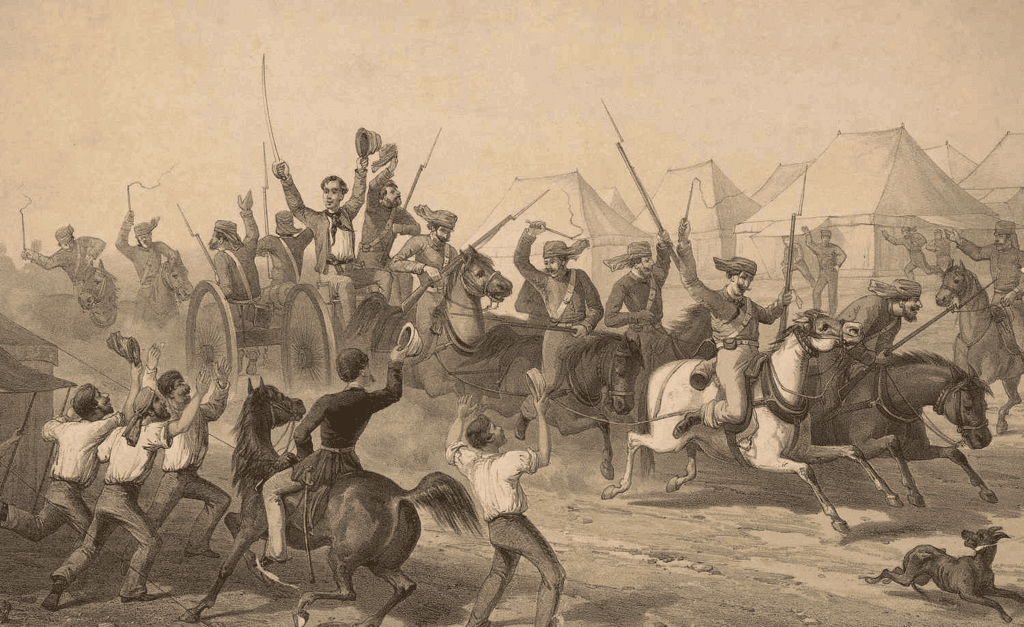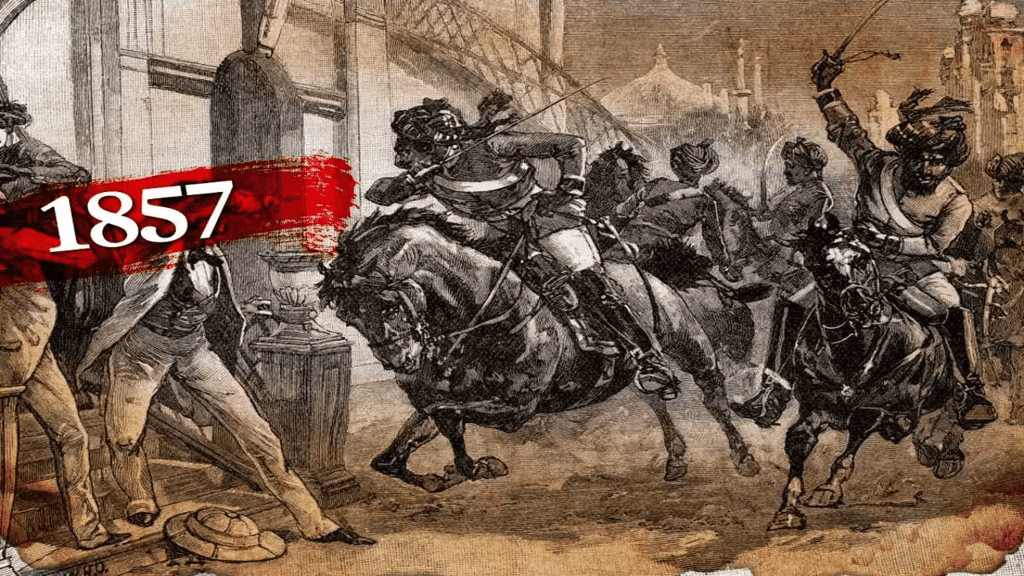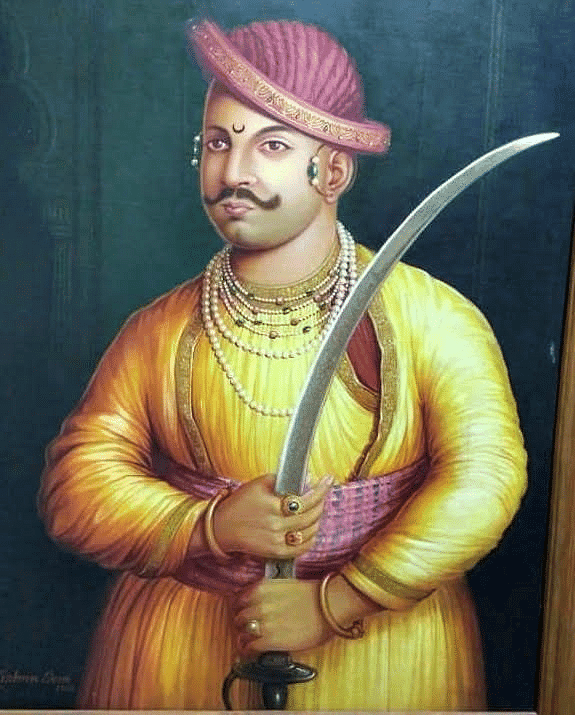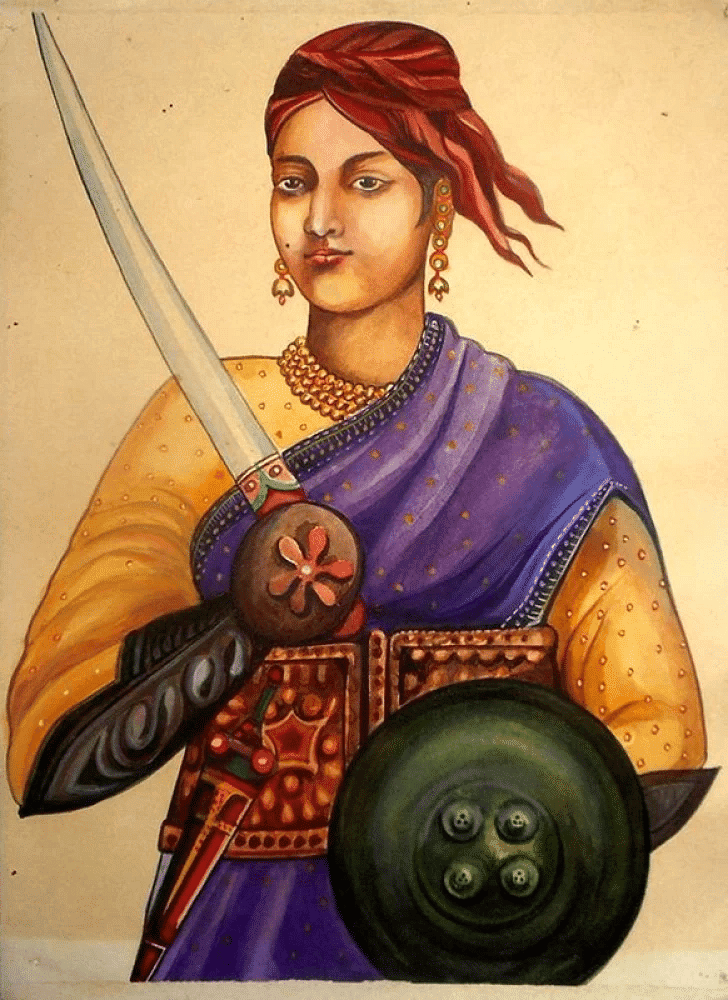Old NCERT Summary (Bipan Chandra): The Revolt of 1857- 2 | History for UPSC CSE PDF Download
Indian Discontent during Colonial Rule
During the period of British colonial rule in India, there was widespread dissatisfaction and even hatred among many Indian people and soldiers towards the foreign administration. This discontent was expressed in various ways, reflecting feelings of oppression and economic exploitation.
 The Revolt of 1857
The Revolt of 1857
Feelings of Degradation and Religious Suppression
- The Indians started to believe that laws were being made to degrade and harm them, as well as to strip them and their fellow countrymen of their religion.
- The English government was viewed as harmful like slow poison, unreliable like a rope of sand, and deceitful like a treacherous flame.
- There was a growing sentiment that escaping the current government's clutches today would only lead to falling into them tomorrow.
- People desired a change in the ruling authority and were enthusiastic about the prospect of British rule being replaced by another form of governance.
Complaints of Economic Exploitation
- A proclamation issued by rebels in Delhi highlighted excessive revenue demands where more money was being collected than was actually owed, leading to impoverishment of the population.
- The imposition of high taxes such as the Chowkeedaree Tax was seen as a deliberate attempt to ruin the people financially.
- The livelihoods of respected and educated individuals were threatened, resulting in a large number of people lacking basic necessities for survival.
- Travelers were subjected to tolls and fees on public roads, further burdening the population economically.
Religious and Social Oppression
- There was a fear that the government intended to undermine the religious beliefs of the population, contributing to a sense of cultural threat and oppression.
- The oppressive actions of the authorities had escalated to the point where the government was perceived as seeking to eradicate the religious practices of the people.
Nature of the Revolt of 1857
The Revolt of 1857 was a significant event in Indian history that emerged from longstanding discontent among the local population towards British rule. It was a culmination of various rebellions and uprisings against British authority that had been brewing for years.
Background Uprisings
Several revolts preceded the Revolt of 1857, including:
- The Kutch Rebellion lasting from 1816 to 1832.
- The Kol Uprising of 1831 in Chota Nagpur.
- The Santhal Uprising of 1855 in the Bhagalpur-Rajmahal region.
Immediate Cause
The immediate trigger for the revolt was:
- The issue of greased cartridges for the new Enfield rifle.
- The use of cartridges greased with beef and pig fat offended Hindu and Muslim sepoys, leading to widespread discontent.
The Beginning of the Revolt
Debate exists on whether the Revolt was spontaneous or part of an organized effort:
- Some believe in a well-organized conspiracy involving secret organizations and key figures like Nana Sahib and Maulavi Ahmad Shah.
- Others argue that there was no concrete evidence of a pre-planned revolt, suggesting it may have been a mix of spontaneity and organization.
Historical Challenges
Understanding the Revolt poses challenges due to:
- Lack of rebel records as they operated clandestinely.
- British suppression of favorable accounts and actions against those sharing the rebel perspective.
The Indian Rebellion of 1857
The Indian Rebellion of 1857, also known as the Sepoy Mutiny, was a significant uprising against British colonial rule in India. The revolt started in Meerut on May 10, 1857, and quickly spread across Northern India, encompassing a vast region from the Punjab in the north to Bihar in the east and Rajputana in the west.

Prelude to the Rebellion
- Before the outbreak in Meerut, incidents like the martyrdom of Mangal Pandey at Barrackpore indicated growing discontent among Indian soldiers.
- On April 24, 1857, ninety men of the 3rd Native Cavalry refused the greased cartridges, leading to their dismissal and imprisonment, sparking a mutiny in Meerut on May 10.
Outbreak and Spread of the Revolt
The mutinous soldiers in Meerut released their comrades, killed officers, and proceeded to Delhi, where they were joined by local infantry, leading to the capture of the city.
The soldiers declared Bahadur Shah as the Emperor of India, making Delhi the focal point of the rebellion and symbolizing unity against British rule.
Transformation into a Revolutionary War
- By elevating Bahadur Shah as a leader, the mutiny evolved into a revolutionary movement, with soldiers from various regions converging on Delhi and pledging loyalty to the Emperor.
- Bahadur Shah advocated for a confederation of Indian states to combat and oust British dominance, influencing rebellious actions across the country.
Spread of the Rebellion
The revolt quickly expanded beyond Meerut, encompassing regions like Avadh, Rohilkhand, Doab, Bundelkhand, Bihar, and East Punjab, shaking off British authority.
While some princely states remained loyal to the British, their troops often rebelled, and smaller chiefs in regions like Rajasthan and Maharashtra garnered support against British rule.
Depth and Breadth of the Revolt of 1857
The Revolt of 1857 in India was a significant event marked by widespread participation and deep-rooted grievances. It wasn't just a military uprising but a popular rebellion involving various sections of society. Here's a simplified breakdown of the details:
The Extent of the Revolt
- The rebellion began with the mutiny of sepoys but quickly spread to involve civilian populations in Northern and Central India.
- Common people joined the uprising, often using traditional weapons like spears, axes, bows, arrows, lathis, and muskets.
- Peasants and artisans played a crucial role, especially in regions like Uttar Pradesh and Bihar, expressing their grievances by targeting money-lenders and new zamindars who had taken over their lands.
Peasant and Artisan Involvement
- The active participation of peasants and zamindars bolstered the revolt, giving it a popular character.
- People attacked British institutions, destroyed records, and disrupted administrative mechanisms to challenge British authority.
- In many battles, civilians outnumbered the sepoys, highlighting the widespread support for the rebellion.
Civilian Support and Resistance
- Even in areas where there was no open revolt, civilians sympathized with the rebels and actively hindered British forces.
- There was social boycott against loyal sepoys, and locals provided false information or withheld support from the British.
- The British faced strong opposition, necessitating a brutal response involving mass punishments and reprisals against villages and individuals.
British Response and Aftermath
- The British had to wage a fierce campaign not just against the sepoys but also against civilians in different regions to suppress the revolt.
- The resistance put up by both sepoys and civilians was valiant, leading to a prolonged conflict despite British efforts.
- The Revolt of 1857 was more than a mere military uprising; it was a widespread rebellion that challenged British rule in various parts of India.
Understanding the Revolt of 1857 in India
The Revolt of 1857, a significant event in Indian history, showcased a remarkable unity between Hindus and Muslims, emphasizing cooperation and mutual respect among diverse groups during a time of political turmoil. Let's break down the key points of this historical event in a simplified manner.
Hindu-Muslim Unity in the Revolt
- Strength in Unity: The Revolt of 1857 derived much of its strength from the unity between Hindus and Muslims, evident among soldiers, leaders, and the general populace.
- Emperor Bahadur Shah: Bahadur Shah, a Muslim emperor, was universally recognized by all rebels as their leader, showcasing a unified front across religious lines.
- Respect for Sentiments: Hindu and Muslim rebels respected each other's beliefs and sentiments, with instances like the immediate ban on cow slaughter in areas of revolt out of respect for Hindu sentiments.
- Equal Representation: Hindus and Muslims held leadership positions at all levels, highlighting a balanced representation of both communities during the revolt.
Key Figures and Centers of the Revolt
- Bahadur Shah and Bakht Khan: While Bahadur Shah held symbolic leadership, the real command rested with General Bakht Khan, representing the popular elements of the rebellion.
- Storm Centers: Delhi, Kanpur, Lucknow, Bareilly, Jhansi, and Arrah in Bihar emerged as focal points of the revolt, each with its unique role and challenges.
- Bahadur Shah's Role: Despite his titular position, Bahadur Shah's wavering support and weak leadership weakened the revolt, compounded by internal intrigues within his circle.
The Revolt of 1857 serves as a historical testament to the unity and complexity of India's diverse communities during a pivotal moment in the country's past.
Key Figures and Leadership in the Revolt of 1857
In the Revolt of 1857 in Modern India, several key figures played significant roles in resisting British rule. Let's break down the complex information into simpler terms:
Nana Sahib's Leadership in Kanpur
- Nana Sahib, the adopted son of Baji Rao II, led the Revolt in Kanpur against the British.
 Nana Saheb
Nana Saheb
- He expelled the English from Kanpur with the help of sepoys and declared himself the Peshwa.
- Nana Sahib recognized Bahadur Shah as the Emperor of India and appointed himself as his Governor.
- Tantia Tope, a loyal servant of Nana Sahib, played a crucial role in the fight through guerrilla tactics.
- Azi-mullah, another loyal follower, specialized in political propaganda.
- Nana Sahib's reputation suffered when he deceitfully killed the garrison in Kanpur despite promising them safe passage.
The Revolt in Lucknow led by the Begum of Avadh
- The Begum of Avadh, along with sepoys, zamindars, and peasants, led the rebellion in Lucknow.
- After the British took refuge in the Residency building, a fierce confrontation ensued.
- Despite the British's strong defense, the siege of the Residency failed due to the resilience and bravery of the small garrison.
Rani Lakshmibai of Jhansi
- Rani Lakshmibai of Jhansi, a prominent figure in the Revolt, fought fiercely against the British.
 Rani Lakshmibai
Rani Lakshmibai
- She joined the rebels after the British disregarded her rights and annexed her state.
- Her courage, military skills, and determination inspired many, and she fought until her death in battle.
Other Leaders in the Revolt
- Kunwar Singh, a zamindar from Bihar, was a key organizer and military leader in the Revolt.
- He fought strategically in Bihar and later joined forces with Nana Sahib in Avadh and Central India.
- Maulavi Ahmadullah, a leader in Avadh, was treacherously killed by the Raja of Puwain.
- His patriotism and military prowess earned him respect, even from British historians.
The Indian Revolt of 1857: Causes and Participants
The Indian Revolt of 1857, also known as the Sepoy Mutiny, was a significant event in India's struggle for independence against British colonial rule. This revolt involved a mix of participants with varying motivations and levels of support, shaping the course and outcome of the rebellion.
Role of Sepoys in the Revolt
- Many sepoys, or Indian soldiers in the British East India Company's army, showed immense bravery and selflessness during the conflict.
- Their determination and sacrifices played a crucial role in nearly driving the British out of India.
- Initially, the revolt was sparked by the issue of greased cartridges, but as the conflict progressed, the sepoys set aside their religious concerns to unite against the common enemy.
Limited Participation and Opposition
- Despite widespread discontent among the Indian populace, the revolt did not have universal support across the country. Many Indian rulers and influential landowners, such as the zamindars, chose not to join the uprising, fearing British reprisals.
- Several prominent rulers like Sindhia of Gwalior, Holkar of Indore, and others actively aided the British in quelling the rebellion, acting as impediments to the revolt's success.
Divisions Among Classes and Regions
- The revolt did not garner backing from all social classes or regions in India. While areas like Madras, Bombay, Bengal, and Western Punjab remained largely unaffected, regions like Avadh saw support from discontented peasants and zamindars.
- The middle and upper classes generally distanced themselves from the rebels. Even the taluqdars of Avadh abandoning the cause once assured of the return of their estates by the British.
Economic Factors and Opposition from Moneylenders and Merchants
- Villagers targeted moneylenders during the revolt, leading to their hostility towards the uprising.
- Merchants, too, turned against the rebels as heavy taxation and seizures of goods affected their businesses.
- The loyalty of Bengal zamindars to the British stemmed from their economic ties and the fear of peasant uprisings.
- Similarly, merchants in major cities like Bombay, Calcutta, and Madras sided with the British due to their economic interests in foreign trade.
Attitudes of Modern Educated Indians
- Educated Indians, seeking progress and modernization for the country, did not support the revolt as they viewed it as regressive and rooted in superstition. They believed British rule offered a path to modernization, contrasting it with what they perceived as backwardness associated with the rebels.
- Over time, educated Indians realized the limitations of foreign rule in promoting their country's advancement, reflecting on the complexities of India's struggle for independence.
Limitations of the Indian Revolutionaries in 1857
The revolutionaries of 1857 sought to challenge British rule in India. However, they faced several challenges and limitations that hindered their success.
Evolving Vision of Modernization
- The revolutionaries aimed to resist foreign rule but lacked a clear vision for modernizing India.
- They did not grasp that outdated customs and institutions contributed to foreign dominance.
- The educated class recognized the need for a modern society, economy, education, and political system.
Disunity and Weaknesses
- The rebels lacked unity and coordination, leading to their downfall.
- They were deficient in modern weapons, relying on antiquated tools like pikes and swords.
- The rebel forces were disorganized and lacked centralized leadership.
Leadership Challenges
- Internal conflicts and selfishness among leaders undermined the rebellion's strength.
- Lack of a common plan of action and infighting weakened their cause.
- The rebels struggled to establish a new power structure after overthrowing British rule.
Peasant Passivity and British Suppression
- The peasantry, after initial actions, became passive due to a lack of direction.
- Destruction of records and overthrow of local authorities left them uncertain about the next steps.
- The British effectively quashed the rebellion by targeting leaders one by one.
The Weaknesses of the Revolt
- The Revolt of 1857 faced challenges beyond individual failures. It lacked a cohesive and forward-looking plan for governing post-British rule.
- The movement comprised diverse factions united by a common disdain for British rule but with varying grievances and political visions for a free India.
- The absence of a progressive agenda allowed feudal leaders to dominate the movement, although their historical failures cast doubts on their ability to establish a new unified Indian state.
Evolving Leadership and Unity
- Despite its feudal roots, the Revolt gradually spurred the emergence of new leadership styles as individuals strived for success, necessitating innovative organizational structures.
- Early Indian patriotism was localized, lacking a sense of national identity. The Revolt, however, played a crucial role in fostering a unified Indian consciousness and a shared national identity.
Suppression of the Revolt
- The British, with their superior military might, quelled the Revolt by deploying significant resources, ultimately overpowering the rebels.
- Key moments in the suppression included the fall of Delhi, the capture and exile of Emperor Bahadur Shah, and the defeat and demise of prominent rebel leaders like Nana Sahib and Tantia Tope.
- By the end of 1859, British authority was fully reestablished, marking the end of the Revolt. However, the event was not in vain, serving as a pivotal moment in India's struggle for independence.
Legacy of the Revolt
- The Revolt of 1857, though unsuccessful, laid the groundwork for the modern Indian national movement, inspiring future generations in their fight against British imperialism.
- The heroic actions of the rebels, despite being suppressed, became iconic in Indian history, symbolizing the nation's resilience and spirit in the face of adversity.
|
216 videos|855 docs|219 tests
|
FAQs on Old NCERT Summary (Bipan Chandra): The Revolt of 1857- 2 - History for UPSC CSE
| 1. What were the main causes of the Indian Rebellion of 1857? |  |
| 2. Who were some of the key figures and leaders involved in the Revolt of 1857? |  |
| 3. What were the limitations faced by the Indian revolutionaries during the Revolt of 1857? |  |
| 4. How did the British East India Company respond to the Revolt of 1857? |  |
| 5. What was the impact and legacy of the Indian Rebellion of 1857 on the Indian independence movement? |  |
















